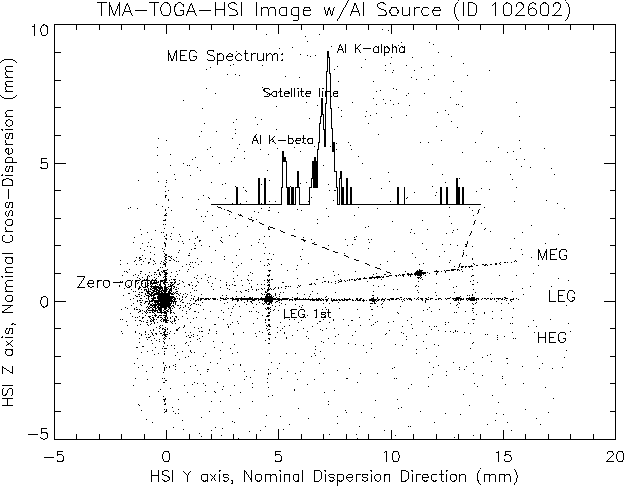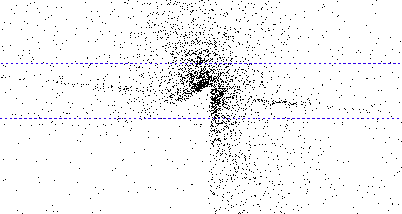

Grating Roll angle Period LEG -0.9073 deg 9915.7 A MEG 3.9489 deg 4004.5 A HEG -5.9974 deg 2002.3 A
This mystery WAS a bump of counts seen on the firstlight MEG histrogram ~100 microns (1%) from the main peak. What is the bump?

The "bump" is a "satellite" line as also observed by the XMM group at their Panter tests (see Paerels et al. in SPIE Vol. 2283, pp107-118.) They see a line on the high-energy side of Mg K-alpha, at 1.008 times the main peak, dE/E = 125. They mention that this shows up for Al and Si anodes as well.
[Kathy's HSI thoughts] - still important even with mystery solved.
Please see http://space.mit.edu.ezproxyberklee.flo.org/HETG/LRF/scatter.html for scatter information.

The FPC with a 500 um pin hole was used to measure the effective are of the TMA-TOGA combination at Al-K in the order-set: [0, +/-1, +/-2, +/-3, +/- 5]. These were MST ID numbers 102942-102976, except '949,'952-955,'965,'971,'973.
The focal plane FPC data were normalized to one of the BND-H FPCs. Given the one free parameter of the area of the BND-H reference detector, the 27 measurements can be turned into TMA-TOGA effective areas and compared with predictions.
The comparison is pretty good all things considered EXCEPT for the LEG and MEG second orders which are an order of magnitude larger than predicted. They and the HEG 2nd order are all measured at a value of about 0.1 cm^2, which is suspicious. Finally, the grating models that went into these prediction are rectangular (line/period ratios for LEG and MEG are 52% and 53%) and so should have a reasonable approximation to the 2nd order value. If the line/period ratios are changed to 57% and 58% the second order can be fit reasonably but then the fifth orders are not fit well...
(10:30/96) As Peter Predehl points out, much more accurate models can be made by i) using non-rectangular shapes (for the LEGs, using the trapezoid model determined by the IR data; for HEGs and MEGs using the bar-shape model the X-GEF data are fit to), and ii) by summing over the many different individual grating models. This has been implemented for the TOGA gratings using John Davis's "multi.sl" s/w.
The plots below have included on them these improved model predictions (squares and Xs). Horizontal lines are again the rectangular predictions for comparison. Better agreement with the XRCF data is obtained (to the improved models) when a "geometric" area for the monitor FPC is taken as the Herman relayed value that Hank calculated of 40.46 cm^2.
There is mounting annecdotal evidence that the focal plane FPC may have lower low-energy efficiency than predicted. While not a grating mystery per se it is possibly related to two grating related puzzles:
The Penning source was run and showed 56 A and 131 A lines with the gratings/HSI as expected. But when the FPC was put at zero-order with a 36 mm aperture the count rate was very low. (Jiahong)
9/5/96, Harvey writes: Dan, I hope MY data gets treated with appropriate respect. I had meant to tell you (but left before I saw you) that the SSD (500 micron aperture) TOGA data seemed to agree very well with FPC count rates EXCEPT in zero order where the SSD rate was 15-20% higher and the difference varied from MEG to HEG to LEG (if I remember correctly). I suppose if the source is not a pure line (which it is not) and the zero order data are collected over a broad energy window, then maybe one could get more counts in the SSD (except I would have thought that the FPC had a greater efficiency at lower energies if that's where the excess counts are). Anyway, you might want to look into this or maybe you already know the explanation.
The HETG dispersion directions are about 15 arc minute from their nominal values of +/- 5 degrees. This error (within spec of 30 arc minute) was traced to 3 arc minutes due to HETG alignment as-installed at XRCF and 11.7/12 arc minutes error in the HEG/MEG roll angle as set at MIT. Dick Elder did experiments to determine the NE80 values and notes the importance of having the beam-splitting cube aligned in all three axes.
The XRCF Phase 1C grating alignment tests ("AL")